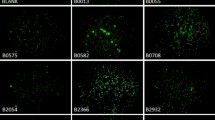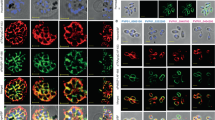Abstract
Nematodes produce two classes of small, helix-rich fatty acid- and retinol-binding proteins whose structures and in vivo functions remain to be elucidated. These are the polyprotein allergens (NPA) and the FAR proteins. The solution properties of recombinant forms of these proteins from parasitic [Ascaris suum (As) and Onchocerca volvulus (Ov)] and free-living [Caenorhabditis elegans (Ce)] nematodes have been examined. Analytical ultracentrifugation (AUC) showed that, contrary to previous findings, the rAs-NPA-1A polyprotein unit (~15 kDa) is a monomer, and this stoichiometry is unaltered by ligand (oleic acid) binding. The rOv-FAR-1 and rCe-FAR-5 proteins differ in that the former forms a tight dimer and the latter a monomer, and these oligomeric states are also unaffected by ligand binding or protein concentration. Sedimentation equilibrium experiments showed that the partial specific volume v̄ of the unliganded proteins agree well with the value calculated from amino acid composition extrapolated to experimental temperature, and was unaffected upon ligand binding. Data from small-angle X-ray scattering (SAXS) indicated that both of the monomeric proteins rAs-NPA-1A and rCe-FAR-5 are globular, although slightly elongated and flattened. These data are in good agreement with shapes predicted from sedimentation velocity experiments and hydrodynamic bead modelling. On the basis of functional and secondary structural homology with the ligand-binding domain of the retinoic acid receptor RXRα, de novo atomic resolution structures for rAs-NPA-1A and rCe-FAR-5 have been constructed which are consistent with the SAXS and hydrodynamic data.








Similar content being viewed by others
References
Ackerman CJ, Harnett MM, Harnett W, Svergun DI, Byron O (2003) 19 Å solution structure of the filarial nematode immunomodulatory protein, ES-62. Biophys J 84:489–500
Altschul SF, Madden TL, Schaffer AA, Zhang J, Zhang Z, Miller W, Lipman DJ (1997) Gapped BLAST and PSI-BLAST: a new generation of protein database search programs. Nucleic Acids Res 25:3389–3402
Aszódi A, Taylor WR (1994) Folding polypeptide alpha-carbon backbones by distance geometry methods. Biopolymers 34:498–505
Aszódi A, Gradwell MJ, Taylor WR (1995) Global fold determination from a small number of distance restraints. J Mol Biol 251:308–326
Barrett J, Saghir N, Timanova A, Clarke K, Brophy PM (1997) Characterisation and properties of an intracellular lipid-binding protein from the tapeworm Moniezia expansa. Eur J Biochem 250:269–275
Berger B, Wilson DB, Wolf E, Tonchev T, Milla M, Kim PS (1995) Predicting coiled coils by use of pairwise residue correlations. Proc Nat Acad Sci USA 92:8259–8263
Blaxter M (1998) Caenorhabditis elegans is a nematode. Science 282:2041–2046
Bourguet W, Ruff M, Chambon P, Gronemeyer H, Moras D (1995) Crystal structure of the ligand binding domain of the human nuclear receptor RXRα. Nature 375:377–382
Britton C, Moore C, Gilleard JS, Kennedy MW (1995) Extensive diversity in repeat unit sequences of the cDNA encoding the polyprotein antigen/allergen from the bovine lungworm Dictyocaulus viviparus. Mol Biochem Parasitol 72:77–88
Burkhard P, Stetefeld J, Strelkov SV (2001) Coiled coils: a highly versatile protein folding motif. Trends Cell Biol 11:82–88
Christie JF, Dunbar B, Davidson I, Kennedy MW (1990) N-terminal amino acid sequence identity between a major allergen of Ascaris lumbricoides and Ascaris suum, and MHC-restricted IgE responses to it. Immunology 69:596–602
Coe NR, Bernlohr DA (1998) Physiological properties and functions of intracellular fatty acid-binding proteins. Biochim Biophys Acta 1391:287–306
Corpet F (1988) Multiple sequence alignment with hierarchical clustering. Nucleic Acids Res 16:10881–10890
Cuff JA, Barton GJ (1999) Evaluation and improvement of multiple sequence methods for protein secondary structure prediction. Proteins Struct Funct Genet 34:508–519
Cuff JA, Clamp ME, Siddiqui AS, Finlay M, Barton GJ (1998) JPred: a consensus secondary structure prediction server. Bioinformatics 14:892–893
Duel HJ (1951) The lipids: their chemistry and biochemistry. Interscience, New York
Durchschlag H (1986) Specific volumes of biological macromolecules and some other molecules of biological interest. In: Hinz H-J (ed) Thermodynamic data for biochemistry and biotechnology. Springer, Berlin Heidelberg New York, pp 45–128
Edelstein SJ, Schachman HK (1973) Measurement of partial specific volume by sedimentation equilibrium in H2O-D2O solutions. Methods Enzymol 27:82–98
Eftink MR, Ghiron CA (1976) Exposure of tryptophanyl residues in proteins: quantitative determination by fluorescence quenching studies. Biochemistry 15:672–679
Eftink MR, Ghiron CA (1984) Indole fluorescence quenching studies on proteins and model systems: use of the efficient quencher succinimide. Biochemistry 23:3891–3899
Flower DR (1996) The lipocalin protein family: structure and function. Biochem J 318:1–14
García de la Torre J (2001) Hydration from hydrodynamics. General considerations and applications of bead modelling to globular proteins. Biophys Chem 93:159–170
García de la Torre J, Huertas ML, Carrasco B (2000) Calculation of hydrodynamic properties of globular proteins from their atomic-level structure. Biophys J 78:719–730
Garofalo A, Kläger SL, Rowlinson MC, Nirmalan N, Klion A, Allen JE, Kennedy MW, Bradley JE (2002) The FAR proteins of filarial nematodes: secretion, glycosylation and lipid binding characteristics. Mol Biochem Parasitol 122:161–170
Garofalo A, Rowlinson M-C, Ngwa A, Hughes JM, Kelly SM, Price NC, Cooper A, Watson DG, Kennedy MW, Bradley JE (2003) The FAR protein family of the nematode Caenorhabditis elegans. Differential lipid binding properties, structural characteristics and developmental regulation. J Biol Chem 278:8065–8074
Gill SC, von Hippel PH (1989) Calculation of protein extinction coefficients from amino-acid sequence data. Anal Biochem 182:319–326
Guex N, Diemand A, Peitsch MC (1999) Protein modelling for all. Trends Biol Sci 24:364–367
Haughland RP (1996) Handbook of fluorescent probes and research chemicals, 6th edn. Molecular Probes, Eugene, Ore., USA
Janssen D, Barrett J (1995) A novel lipid-binding protein from the cestode Moniezia expansa. Biochem J 311:49–57
Kennedy MW (2000) The polyprotein lipid binding proteins of nematodes. Biochim Biophys Acta 1476:149–164
Kennedy MW (2001) Structurally novel lipid-binding proteins. In: Kennedy MW, Harnett W (eds) Parasitic nematodes. Molecular biology, biochemistry, and immunology. CABI, Wallingford, UK, pp 309–330
Kennedy MW, Qureshi F (1986) Stage-specific secreted antigens of the parasitic larval stages of the nematode Ascaris. Immunology 58:515–522
Kennedy MW, Qureshi F, Fraser EM, Haswell-Elkins MR, Smith HV (1989) Antigenic relationships between the surface-exposed, secreted and somatic materials of the nematode parasites Ascaris lumbricoides, Ascaris suum, and Toxocara canis. Clin Exp Immunol 75:493–500
Kennedy MW, Brass A, McCruden AB, Price NC, Kelly SM, Cooper A (1995a) The ABA-1 allergen of the parasitic nematode Ascaris suum: fatty acid and retinoid binding function and structural characterisation. Biochemistry 34:6700–6710
Kennedy MW, Britton C, Price NC, Kelly SM, Cooper A (1995b) The DvA-1 polyprotein of the parasitic nematode Dictyocaulus viviparus: a small helix-rich lipid binding protein. J Biol Chem 270:19277–19281
Kennedy MW, Garside LH, Goodrick LE, McDermott L, Brass A, Price NC, Kelly SM, Cooper A, Bradley JE (1997) The Ov20 protein of the parasitic nematode Onchocerca volvulus. A structurally novel class of small helix-rich retinol-binding proteins. J Biol Chem 272:29442–29448
Kozin MB, Svergun DI (2001) Automated matching of high- and low-resolution structural models. J Appl Crystallogr 34:33–41
Lerche MH, Poulsen FM (1998) Solution structure of barley lipid transfer protein complexed with palmitate. Two different binding modes of palmitate in the homologous maize and barley nonspecific lipid transfer proteins. Protein Sci 7:2490–2498
Lupas A, Van Dyke M, Stock J (1991) Predicting coiled coils from protein sequences. Science 252:1162–1164
MacGregor RB, Weber G (1986) Estimation of the polarity of the protein interior by optical spectroscopy. Nature 319:70–73
McDermott L, Moore J, Brass A, Price NC, Kelly SM, Cooper A, Kennedy MW (2001) Mutagenic and chemical modification of the ABA-1 allergen of the nematode Ascaris: consequences for structure and lipid-binding properties. Biochemistry 41:9918–9926
Moore J, McDermott L, Price NC, Kelly SM, Cooper A, Kennedy MW (1999) Sequence-divergent units of the ABA-1 polyprotein array of the nematode Ascaris suum have similar fatty-acid- and retinol-binding properties but different binding-site environments. Biochem J 340:337–343
Peitsch MC (1996) ProMod and Swiss-Model: internet-based tools for automated comparative protein modelling. Biochem Soc Trans 24:274–279
Prior A, Jones JT, Blok VC, Beauchamp J, McDermott L, Cooper A, Kennedy MW (2001) A surface-associated retinol- and fatty acid-binding protein (Gp-FAR-1) from the potato cyst nematode Globodera pallida: lipid binding activities, structural analysis and expression pattern. Biochem J 356:387–394
Rothnagel JA, Steinert PM (1990) The repeating strucure of the units for mouse filaggrin and a comparison of the repeating units. J Biol Chem 265:1862–1865
Schuck P (2000) Size-distribution analysis of macromolecules by sedimentation velocity ultracentrifugation and Lamm equation modeling. Biophys J 78:1606–1619
Scott DJ, Grossmann JG, Tame JRH, Byron O, Wilson KS, Otto BR (2002) Low resolution structure of the apo form of Escherichia coli haemoglobin protease Hbp. J Mol Biol 315:1179–1187
Storch J, Thumser AE (2000) The fatty acid transport function of fatty acid-binding proteins. Biochim Biophys Acta 1486:28–44
Svergun DI (1992) Determination of the regularisation parameter in indirect-transform methods using perceptual criteria. J Appl Crystallogr 25:495–503
Svergun DI (1999) Restoring low resolution structure of biological macromolecules from solution scattering using simulated annealing. Biophys J 76:2879–2886
Svergun DI, Petoukhov MV, Koch MHJ (2001) Determination of domain structure of proteins from X-ray solution scattering. Biophys J 80:2946–2953
Taylor WR, Aszódi A (1994) Building protein folds using distance geometry: towards a general modelling and prediction method. In: Merz JM Jr, LeGrand SM (eds) The protein folding problem and tertiary structure prediction. Birkhäuser, Boston, pp 165–192
Xia Y, Spence HJ, Moore J, Heaney N, McDermott L, Cooper A, Watson DG, Mei B, Komuniecki R, Kennedy MW (2000) The ABA-1 allergen of Ascaris lumbricoides: sequence polymorphism, stage and tissue-specific expression, lipid binding function, and protein biophysical properties. Parasitology 120:211–224
Yphantis DA (1964) Equilibrium ultracentrifugation of dilute solutions. Biochemistry 3:297–317
Yphantis DA, Waugh DF (1956) Ultracentrifugal charactersiation by direct measurement of activity. I. Theoretical. J Phys Chem 60:623–635
Acknowledgements
A.S.S. is supported by a grant from the Wellcome Trust to O.B., M.W.K. and others (05606/Z/99/Z), and we are also indebted to the Wellcome Trust for their support of this project through other grants to M.W.K. The work was also supported by an ESRF beam time award (LS-1872) and by the Universities of Salford and Nottingham. Special thanks to the team of Dr. Wim Bras (ESRF, Grenoble, particularly Dr. Marc Malfois) for assistance in the SAXS experiments and Marcelo Nöllmann for help in SAXS data treatment.
Author information
Authors and Affiliations
Corresponding author
Additional information
Presented at the Conference for Advances in Analytical Ultracentrifugation and Hydrodynamics, 8–11 June 202, Grenoble, France
Rights and permissions
About this article
Cite this article
Solovyova, A.S., Meenan, N., McDermott, L. et al. The polyprotein and FAR lipid binding proteins of nematodes: shape and monomer/dimer states in ligand-free and bound forms. Eur Biophys J 32, 465–476 (2003). https://doi.org/10.1007/s00249-003-0297-8
Received:
Revised:
Accepted:
Published:
Issue Date:
DOI: https://doi.org/10.1007/s00249-003-0297-8




